Case Study Analysis: Nursing Care of Aboriginal Patient Kathleen
VerifiedAdded on 2022/08/13
|8
|2177
|15
Case Study
AI Summary
This case study analysis focuses on the nursing care of Kathleen, an Aboriginal patient admitted to the hospital with blood sugar issues and exacerbation of her health conditions. The analysis emphasizes the importance of communication skills, cultural competence, and the development of a therapeutic relationship between the student nurse and the patient. It explores strategies like employing positive and non-discriminatory communication, using pictorial non-verbal communication, and empowering the patient through knowledge and self-efficacy development, particularly in managing COPD and diabetes. The case study also addresses cultural safety, the ethical implications of advance health directives, and the importance of respecting the patient's autonomy while considering legal frameworks like the Mental Capacity Act and Guardianship and Administration Act, 1990. The analysis highlights the student nurse's role in educating and supporting the patient while navigating potential ethical dilemmas and cultural sensitivities.
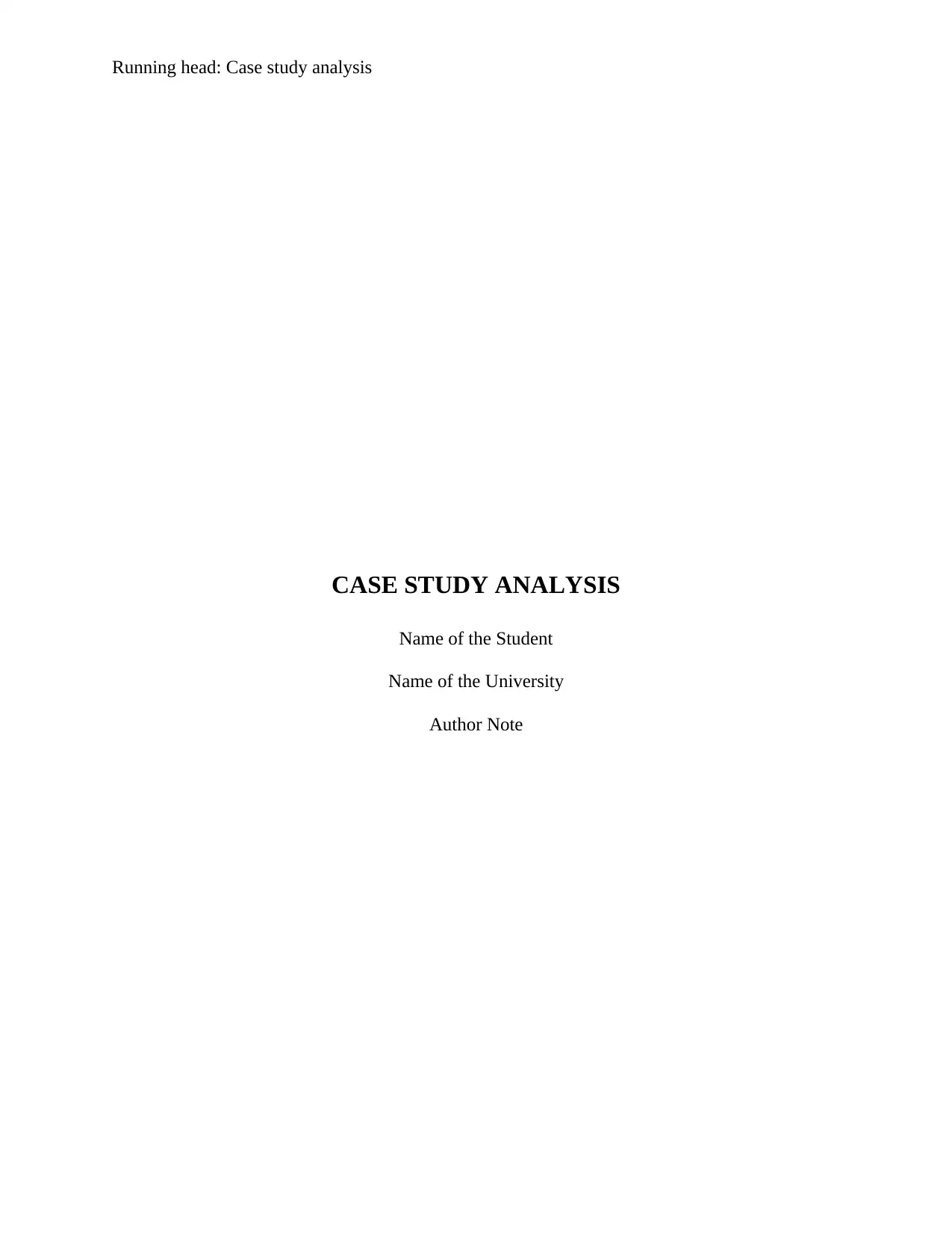
Running head: Case study analysis
CASE STUDY ANALYSIS
Name of the Student
Name of the University
Author Note
CASE STUDY ANALYSIS
Name of the Student
Name of the University
Author Note
Paraphrase This Document
Need a fresh take? Get an instant paraphrase of this document with our AI Paraphraser
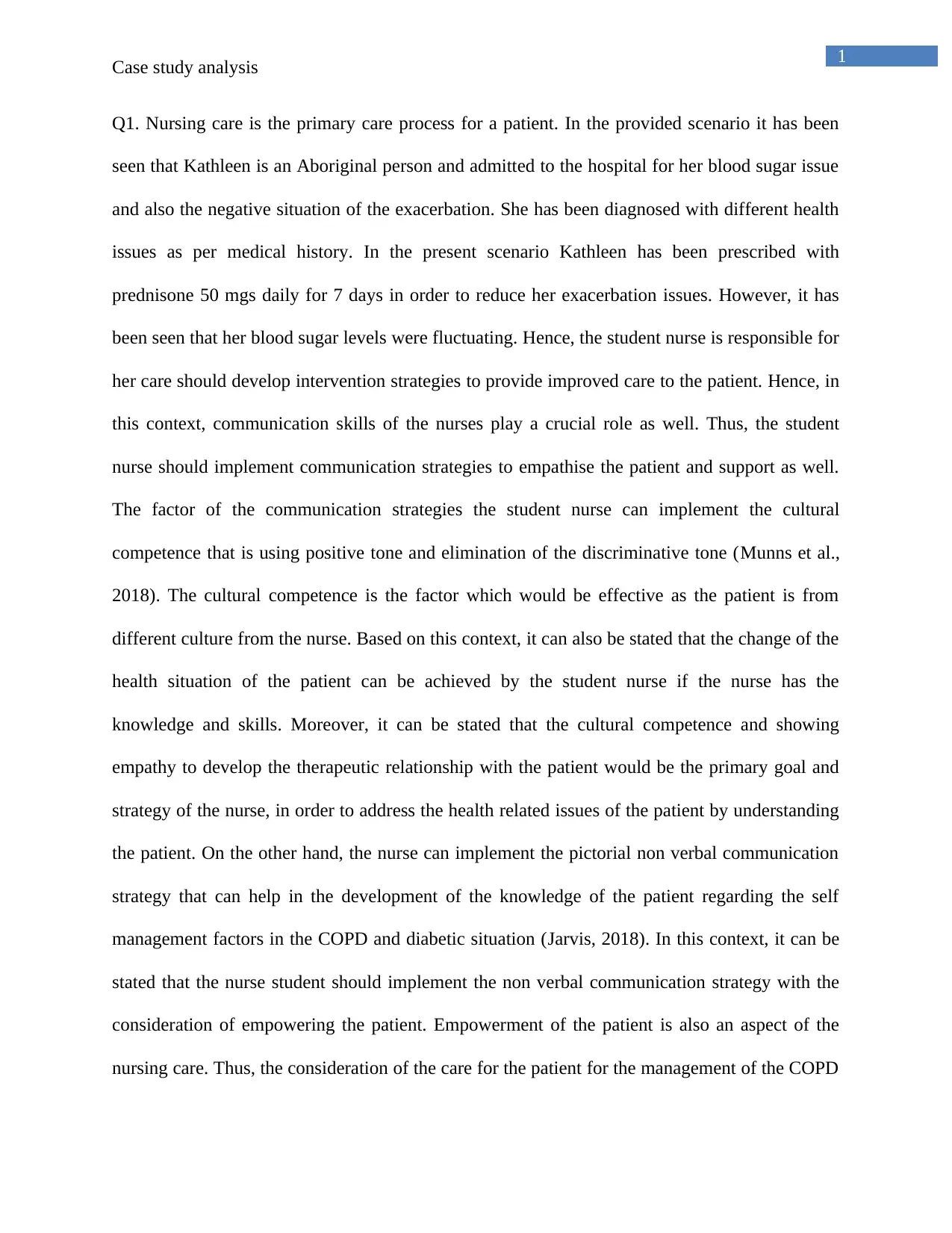
1
Case study analysis
Q1. Nursing care is the primary care process for a patient. In the provided scenario it has been
seen that Kathleen is an Aboriginal person and admitted to the hospital for her blood sugar issue
and also the negative situation of the exacerbation. She has been diagnosed with different health
issues as per medical history. In the present scenario Kathleen has been prescribed with
prednisone 50 mgs daily for 7 days in order to reduce her exacerbation issues. However, it has
been seen that her blood sugar levels were fluctuating. Hence, the student nurse is responsible for
her care should develop intervention strategies to provide improved care to the patient. Hence, in
this context, communication skills of the nurses play a crucial role as well. Thus, the student
nurse should implement communication strategies to empathise the patient and support as well.
The factor of the communication strategies the student nurse can implement the cultural
competence that is using positive tone and elimination of the discriminative tone (Munns et al.,
2018). The cultural competence is the factor which would be effective as the patient is from
different culture from the nurse. Based on this context, it can also be stated that the change of the
health situation of the patient can be achieved by the student nurse if the nurse has the
knowledge and skills. Moreover, it can be stated that the cultural competence and showing
empathy to develop the therapeutic relationship with the patient would be the primary goal and
strategy of the nurse, in order to address the health related issues of the patient by understanding
the patient. On the other hand, the nurse can implement the pictorial non verbal communication
strategy that can help in the development of the knowledge of the patient regarding the self
management factors in the COPD and diabetic situation (Jarvis, 2018). In this context, it can be
stated that the nurse student should implement the non verbal communication strategy with the
consideration of empowering the patient. Empowerment of the patient is also an aspect of the
nursing care. Thus, the consideration of the care for the patient for the management of the COPD
Case study analysis
Q1. Nursing care is the primary care process for a patient. In the provided scenario it has been
seen that Kathleen is an Aboriginal person and admitted to the hospital for her blood sugar issue
and also the negative situation of the exacerbation. She has been diagnosed with different health
issues as per medical history. In the present scenario Kathleen has been prescribed with
prednisone 50 mgs daily for 7 days in order to reduce her exacerbation issues. However, it has
been seen that her blood sugar levels were fluctuating. Hence, the student nurse is responsible for
her care should develop intervention strategies to provide improved care to the patient. Hence, in
this context, communication skills of the nurses play a crucial role as well. Thus, the student
nurse should implement communication strategies to empathise the patient and support as well.
The factor of the communication strategies the student nurse can implement the cultural
competence that is using positive tone and elimination of the discriminative tone (Munns et al.,
2018). The cultural competence is the factor which would be effective as the patient is from
different culture from the nurse. Based on this context, it can also be stated that the change of the
health situation of the patient can be achieved by the student nurse if the nurse has the
knowledge and skills. Moreover, it can be stated that the cultural competence and showing
empathy to develop the therapeutic relationship with the patient would be the primary goal and
strategy of the nurse, in order to address the health related issues of the patient by understanding
the patient. On the other hand, the nurse can implement the pictorial non verbal communication
strategy that can help in the development of the knowledge of the patient regarding the self
management factors in the COPD and diabetic situation (Jarvis, 2018). In this context, it can be
stated that the nurse student should implement the non verbal communication strategy with the
consideration of empowering the patient. Empowerment of the patient is also an aspect of the
nursing care. Thus, the consideration of the care for the patient for the management of the COPD
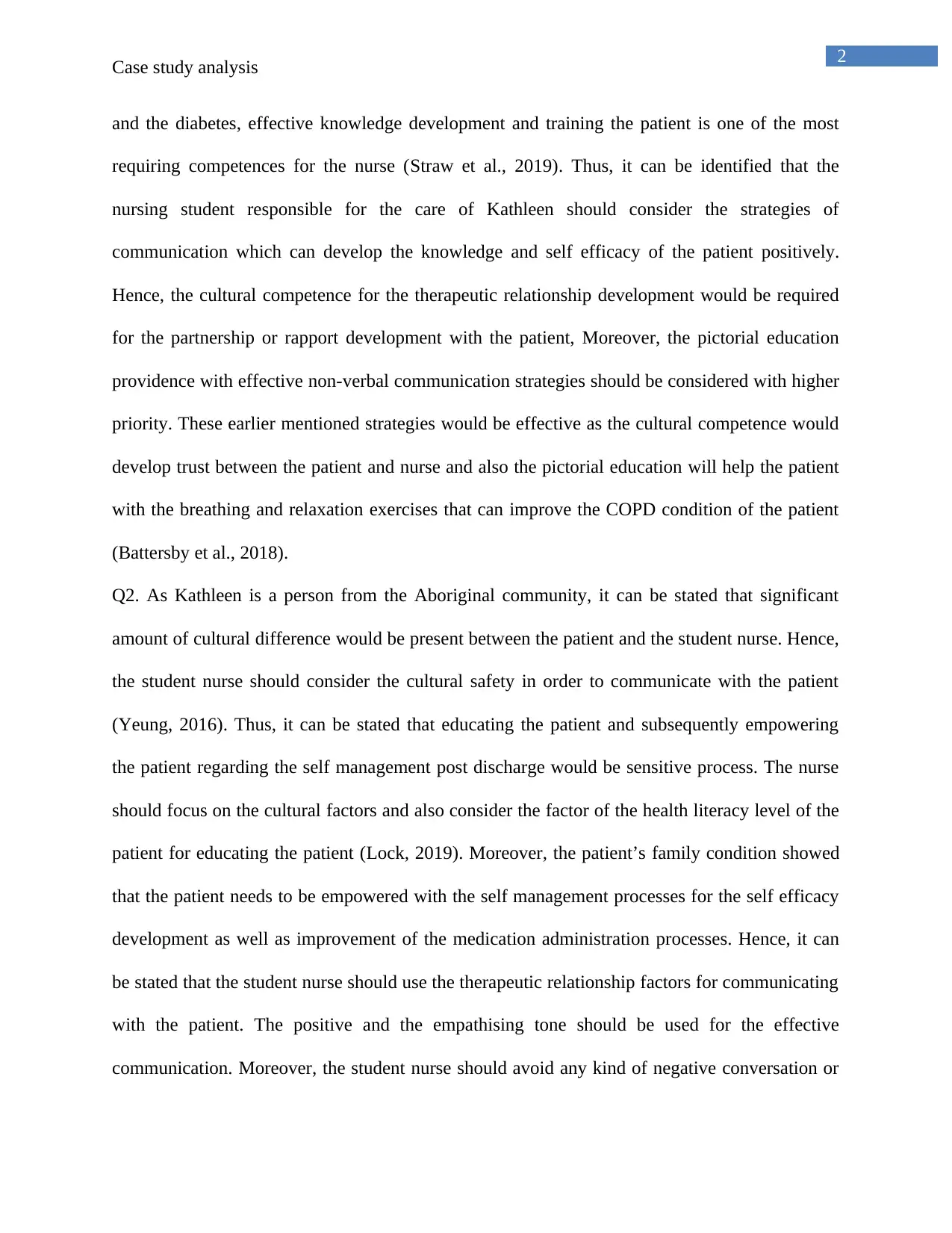
2
Case study analysis
and the diabetes, effective knowledge development and training the patient is one of the most
requiring competences for the nurse (Straw et al., 2019). Thus, it can be identified that the
nursing student responsible for the care of Kathleen should consider the strategies of
communication which can develop the knowledge and self efficacy of the patient positively.
Hence, the cultural competence for the therapeutic relationship development would be required
for the partnership or rapport development with the patient, Moreover, the pictorial education
providence with effective non-verbal communication strategies should be considered with higher
priority. These earlier mentioned strategies would be effective as the cultural competence would
develop trust between the patient and nurse and also the pictorial education will help the patient
with the breathing and relaxation exercises that can improve the COPD condition of the patient
(Battersby et al., 2018).
Q2. As Kathleen is a person from the Aboriginal community, it can be stated that significant
amount of cultural difference would be present between the patient and the student nurse. Hence,
the student nurse should consider the cultural safety in order to communicate with the patient
(Yeung, 2016). Thus, it can be stated that educating the patient and subsequently empowering
the patient regarding the self management post discharge would be sensitive process. The nurse
should focus on the cultural factors and also consider the factor of the health literacy level of the
patient for educating the patient (Lock, 2019). Moreover, the patient’s family condition showed
that the patient needs to be empowered with the self management processes for the self efficacy
development as well as improvement of the medication administration processes. Hence, it can
be stated that the student nurse should use the therapeutic relationship factors for communicating
with the patient. The positive and the empathising tone should be used for the effective
communication. Moreover, the student nurse should avoid any kind of negative conversation or
Case study analysis
and the diabetes, effective knowledge development and training the patient is one of the most
requiring competences for the nurse (Straw et al., 2019). Thus, it can be identified that the
nursing student responsible for the care of Kathleen should consider the strategies of
communication which can develop the knowledge and self efficacy of the patient positively.
Hence, the cultural competence for the therapeutic relationship development would be required
for the partnership or rapport development with the patient, Moreover, the pictorial education
providence with effective non-verbal communication strategies should be considered with higher
priority. These earlier mentioned strategies would be effective as the cultural competence would
develop trust between the patient and nurse and also the pictorial education will help the patient
with the breathing and relaxation exercises that can improve the COPD condition of the patient
(Battersby et al., 2018).
Q2. As Kathleen is a person from the Aboriginal community, it can be stated that significant
amount of cultural difference would be present between the patient and the student nurse. Hence,
the student nurse should consider the cultural safety in order to communicate with the patient
(Yeung, 2016). Thus, it can be stated that educating the patient and subsequently empowering
the patient regarding the self management post discharge would be sensitive process. The nurse
should focus on the cultural factors and also consider the factor of the health literacy level of the
patient for educating the patient (Lock, 2019). Moreover, the patient’s family condition showed
that the patient needs to be empowered with the self management processes for the self efficacy
development as well as improvement of the medication administration processes. Hence, it can
be stated that the student nurse should use the therapeutic relationship factors for communicating
with the patient. The positive and the empathising tone should be used for the effective
communication. Moreover, the student nurse should avoid any kind of negative conversation or
⊘ This is a preview!⊘
Do you want full access?
Subscribe today to unlock all pages.

Trusted by 1+ million students worldwide
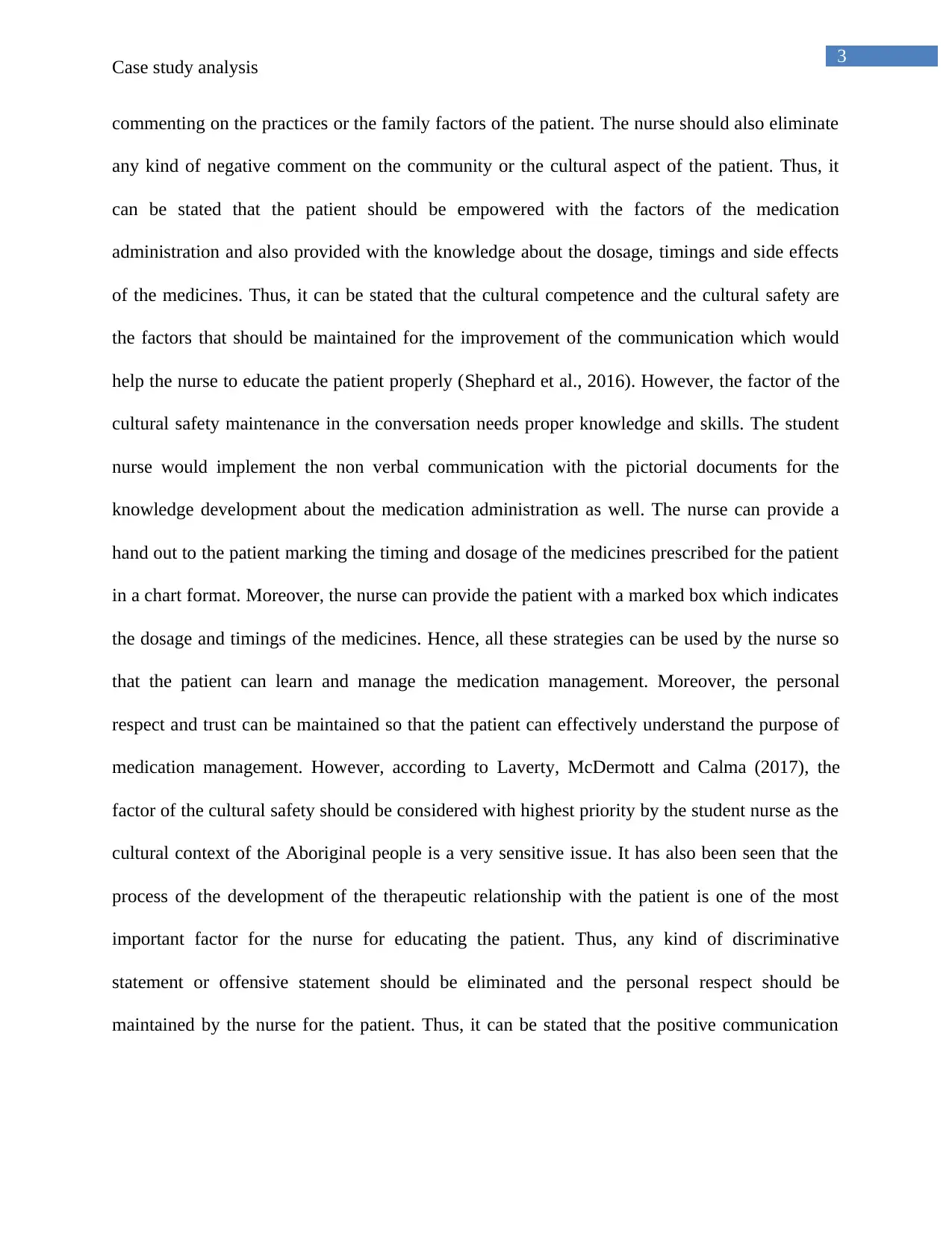
3
Case study analysis
commenting on the practices or the family factors of the patient. The nurse should also eliminate
any kind of negative comment on the community or the cultural aspect of the patient. Thus, it
can be stated that the patient should be empowered with the factors of the medication
administration and also provided with the knowledge about the dosage, timings and side effects
of the medicines. Thus, it can be stated that the cultural competence and the cultural safety are
the factors that should be maintained for the improvement of the communication which would
help the nurse to educate the patient properly (Shephard et al., 2016). However, the factor of the
cultural safety maintenance in the conversation needs proper knowledge and skills. The student
nurse would implement the non verbal communication with the pictorial documents for the
knowledge development about the medication administration as well. The nurse can provide a
hand out to the patient marking the timing and dosage of the medicines prescribed for the patient
in a chart format. Moreover, the nurse can provide the patient with a marked box which indicates
the dosage and timings of the medicines. Hence, all these strategies can be used by the nurse so
that the patient can learn and manage the medication management. Moreover, the personal
respect and trust can be maintained so that the patient can effectively understand the purpose of
medication management. However, according to Laverty, McDermott and Calma (2017), the
factor of the cultural safety should be considered with highest priority by the student nurse as the
cultural context of the Aboriginal people is a very sensitive issue. It has also been seen that the
process of the development of the therapeutic relationship with the patient is one of the most
important factor for the nurse for educating the patient. Thus, any kind of discriminative
statement or offensive statement should be eliminated and the personal respect should be
maintained by the nurse for the patient. Thus, it can be stated that the positive communication
Case study analysis
commenting on the practices or the family factors of the patient. The nurse should also eliminate
any kind of negative comment on the community or the cultural aspect of the patient. Thus, it
can be stated that the patient should be empowered with the factors of the medication
administration and also provided with the knowledge about the dosage, timings and side effects
of the medicines. Thus, it can be stated that the cultural competence and the cultural safety are
the factors that should be maintained for the improvement of the communication which would
help the nurse to educate the patient properly (Shephard et al., 2016). However, the factor of the
cultural safety maintenance in the conversation needs proper knowledge and skills. The student
nurse would implement the non verbal communication with the pictorial documents for the
knowledge development about the medication administration as well. The nurse can provide a
hand out to the patient marking the timing and dosage of the medicines prescribed for the patient
in a chart format. Moreover, the nurse can provide the patient with a marked box which indicates
the dosage and timings of the medicines. Hence, all these strategies can be used by the nurse so
that the patient can learn and manage the medication management. Moreover, the personal
respect and trust can be maintained so that the patient can effectively understand the purpose of
medication management. However, according to Laverty, McDermott and Calma (2017), the
factor of the cultural safety should be considered with highest priority by the student nurse as the
cultural context of the Aboriginal people is a very sensitive issue. It has also been seen that the
process of the development of the therapeutic relationship with the patient is one of the most
important factor for the nurse for educating the patient. Thus, any kind of discriminative
statement or offensive statement should be eliminated and the personal respect should be
maintained by the nurse for the patient. Thus, it can be stated that the positive communication
Paraphrase This Document
Need a fresh take? Get an instant paraphrase of this document with our AI Paraphraser
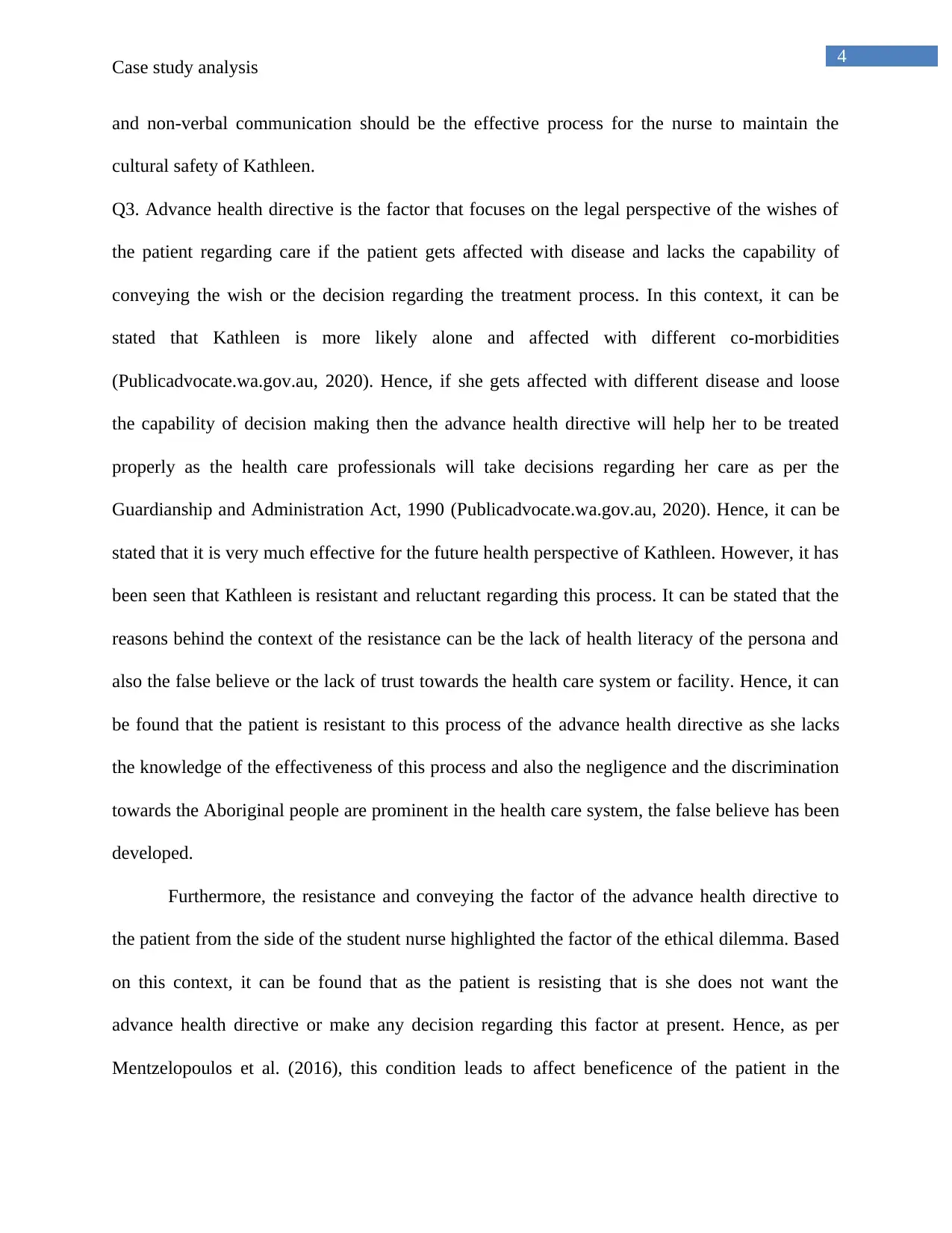
4
Case study analysis
and non-verbal communication should be the effective process for the nurse to maintain the
cultural safety of Kathleen.
Q3. Advance health directive is the factor that focuses on the legal perspective of the wishes of
the patient regarding care if the patient gets affected with disease and lacks the capability of
conveying the wish or the decision regarding the treatment process. In this context, it can be
stated that Kathleen is more likely alone and affected with different co-morbidities
(Publicadvocate.wa.gov.au, 2020). Hence, if she gets affected with different disease and loose
the capability of decision making then the advance health directive will help her to be treated
properly as the health care professionals will take decisions regarding her care as per the
Guardianship and Administration Act, 1990 (Publicadvocate.wa.gov.au, 2020). Hence, it can be
stated that it is very much effective for the future health perspective of Kathleen. However, it has
been seen that Kathleen is resistant and reluctant regarding this process. It can be stated that the
reasons behind the context of the resistance can be the lack of health literacy of the persona and
also the false believe or the lack of trust towards the health care system or facility. Hence, it can
be found that the patient is resistant to this process of the advance health directive as she lacks
the knowledge of the effectiveness of this process and also the negligence and the discrimination
towards the Aboriginal people are prominent in the health care system, the false believe has been
developed.
Furthermore, the resistance and conveying the factor of the advance health directive to
the patient from the side of the student nurse highlighted the factor of the ethical dilemma. Based
on this context, it can be found that as the patient is resisting that is she does not want the
advance health directive or make any decision regarding this factor at present. Hence, as per
Mentzelopoulos et al. (2016), this condition leads to affect beneficence of the patient in the
Case study analysis
and non-verbal communication should be the effective process for the nurse to maintain the
cultural safety of Kathleen.
Q3. Advance health directive is the factor that focuses on the legal perspective of the wishes of
the patient regarding care if the patient gets affected with disease and lacks the capability of
conveying the wish or the decision regarding the treatment process. In this context, it can be
stated that Kathleen is more likely alone and affected with different co-morbidities
(Publicadvocate.wa.gov.au, 2020). Hence, if she gets affected with different disease and loose
the capability of decision making then the advance health directive will help her to be treated
properly as the health care professionals will take decisions regarding her care as per the
Guardianship and Administration Act, 1990 (Publicadvocate.wa.gov.au, 2020). Hence, it can be
stated that it is very much effective for the future health perspective of Kathleen. However, it has
been seen that Kathleen is resistant and reluctant regarding this process. It can be stated that the
reasons behind the context of the resistance can be the lack of health literacy of the persona and
also the false believe or the lack of trust towards the health care system or facility. Hence, it can
be found that the patient is resistant to this process of the advance health directive as she lacks
the knowledge of the effectiveness of this process and also the negligence and the discrimination
towards the Aboriginal people are prominent in the health care system, the false believe has been
developed.
Furthermore, the resistance and conveying the factor of the advance health directive to
the patient from the side of the student nurse highlighted the factor of the ethical dilemma. Based
on this context, it can be found that as the patient is resisting that is she does not want the
advance health directive or make any decision regarding this factor at present. Hence, as per
Mentzelopoulos et al. (2016), this condition leads to affect beneficence of the patient in the
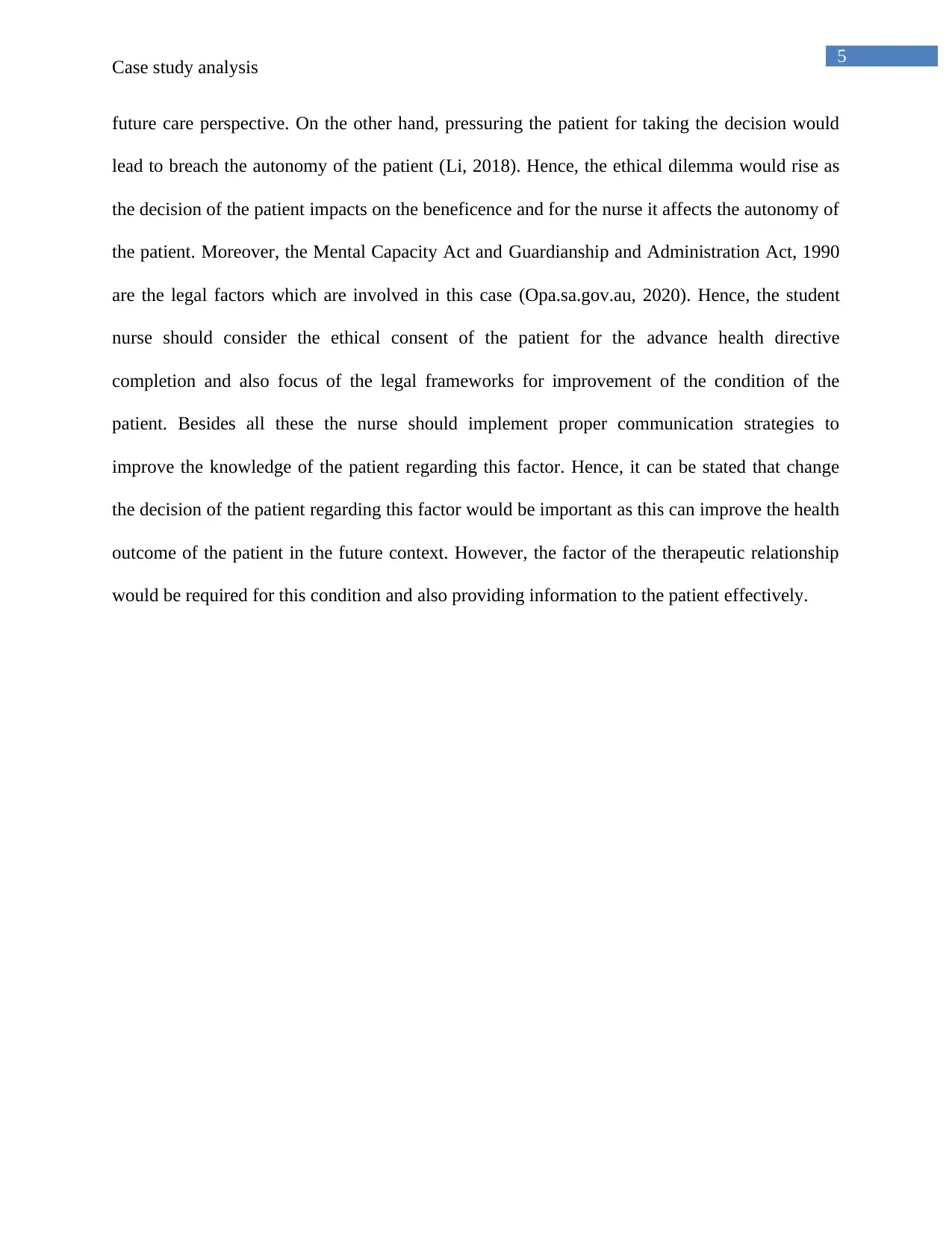
5
Case study analysis
future care perspective. On the other hand, pressuring the patient for taking the decision would
lead to breach the autonomy of the patient (Li, 2018). Hence, the ethical dilemma would rise as
the decision of the patient impacts on the beneficence and for the nurse it affects the autonomy of
the patient. Moreover, the Mental Capacity Act and Guardianship and Administration Act, 1990
are the legal factors which are involved in this case (Opa.sa.gov.au, 2020). Hence, the student
nurse should consider the ethical consent of the patient for the advance health directive
completion and also focus of the legal frameworks for improvement of the condition of the
patient. Besides all these the nurse should implement proper communication strategies to
improve the knowledge of the patient regarding this factor. Hence, it can be stated that change
the decision of the patient regarding this factor would be important as this can improve the health
outcome of the patient in the future context. However, the factor of the therapeutic relationship
would be required for this condition and also providing information to the patient effectively.
Case study analysis
future care perspective. On the other hand, pressuring the patient for taking the decision would
lead to breach the autonomy of the patient (Li, 2018). Hence, the ethical dilemma would rise as
the decision of the patient impacts on the beneficence and for the nurse it affects the autonomy of
the patient. Moreover, the Mental Capacity Act and Guardianship and Administration Act, 1990
are the legal factors which are involved in this case (Opa.sa.gov.au, 2020). Hence, the student
nurse should consider the ethical consent of the patient for the advance health directive
completion and also focus of the legal frameworks for improvement of the condition of the
patient. Besides all these the nurse should implement proper communication strategies to
improve the knowledge of the patient regarding this factor. Hence, it can be stated that change
the decision of the patient regarding this factor would be important as this can improve the health
outcome of the patient in the future context. However, the factor of the therapeutic relationship
would be required for this condition and also providing information to the patient effectively.
⊘ This is a preview!⊘
Do you want full access?
Subscribe today to unlock all pages.

Trusted by 1+ million students worldwide
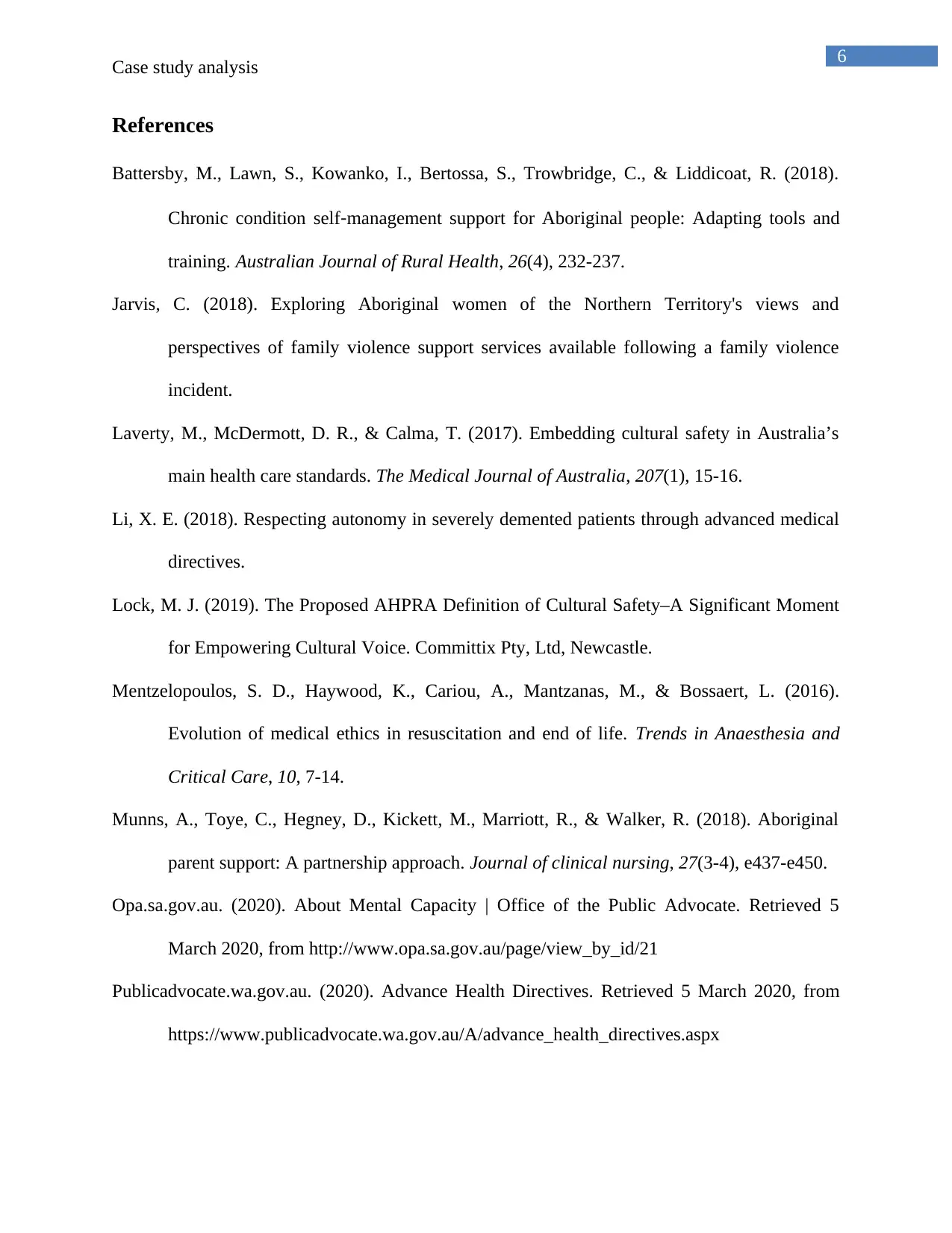
6
Case study analysis
References
Battersby, M., Lawn, S., Kowanko, I., Bertossa, S., Trowbridge, C., & Liddicoat, R. (2018).
Chronic condition self‐management support for Aboriginal people: Adapting tools and
training. Australian Journal of Rural Health, 26(4), 232-237.
Jarvis, C. (2018). Exploring Aboriginal women of the Northern Territory's views and
perspectives of family violence support services available following a family violence
incident.
Laverty, M., McDermott, D. R., & Calma, T. (2017). Embedding cultural safety in Australia’s
main health care standards. The Medical Journal of Australia, 207(1), 15-16.
Li, X. E. (2018). Respecting autonomy in severely demented patients through advanced medical
directives.
Lock, M. J. (2019). The Proposed AHPRA Definition of Cultural Safety–A Significant Moment
for Empowering Cultural Voice. Committix Pty, Ltd, Newcastle.
Mentzelopoulos, S. D., Haywood, K., Cariou, A., Mantzanas, M., & Bossaert, L. (2016).
Evolution of medical ethics in resuscitation and end of life. Trends in Anaesthesia and
Critical Care, 10, 7-14.
Munns, A., Toye, C., Hegney, D., Kickett, M., Marriott, R., & Walker, R. (2018). Aboriginal
parent support: A partnership approach. Journal of clinical nursing, 27(3-4), e437-e450.
Opa.sa.gov.au. (2020). About Mental Capacity | Office of the Public Advocate. Retrieved 5
March 2020, from http://www.opa.sa.gov.au/page/view_by_id/21
Publicadvocate.wa.gov.au. (2020). Advance Health Directives. Retrieved 5 March 2020, from
https://www.publicadvocate.wa.gov.au/A/advance_health_directives.aspx
Case study analysis
References
Battersby, M., Lawn, S., Kowanko, I., Bertossa, S., Trowbridge, C., & Liddicoat, R. (2018).
Chronic condition self‐management support for Aboriginal people: Adapting tools and
training. Australian Journal of Rural Health, 26(4), 232-237.
Jarvis, C. (2018). Exploring Aboriginal women of the Northern Territory's views and
perspectives of family violence support services available following a family violence
incident.
Laverty, M., McDermott, D. R., & Calma, T. (2017). Embedding cultural safety in Australia’s
main health care standards. The Medical Journal of Australia, 207(1), 15-16.
Li, X. E. (2018). Respecting autonomy in severely demented patients through advanced medical
directives.
Lock, M. J. (2019). The Proposed AHPRA Definition of Cultural Safety–A Significant Moment
for Empowering Cultural Voice. Committix Pty, Ltd, Newcastle.
Mentzelopoulos, S. D., Haywood, K., Cariou, A., Mantzanas, M., & Bossaert, L. (2016).
Evolution of medical ethics in resuscitation and end of life. Trends in Anaesthesia and
Critical Care, 10, 7-14.
Munns, A., Toye, C., Hegney, D., Kickett, M., Marriott, R., & Walker, R. (2018). Aboriginal
parent support: A partnership approach. Journal of clinical nursing, 27(3-4), e437-e450.
Opa.sa.gov.au. (2020). About Mental Capacity | Office of the Public Advocate. Retrieved 5
March 2020, from http://www.opa.sa.gov.au/page/view_by_id/21
Publicadvocate.wa.gov.au. (2020). Advance Health Directives. Retrieved 5 March 2020, from
https://www.publicadvocate.wa.gov.au/A/advance_health_directives.aspx
Paraphrase This Document
Need a fresh take? Get an instant paraphrase of this document with our AI Paraphraser

7
Case study analysis
Shephard, M., O’Brien, C., Burgoyne, A., Croft, J., Garlett, T., Barancek, K., ... & Shephard, A.
(2016). Review of the cultural safety of a national Indigenous point-of-care testing
program for diabetes management. Australian journal of primary health, 22(4), 368-374.
Straw, S., Spry, E., Yanawana, L., Matsumoto, V., Cox, D., Cox, E., ... & Marley, J. V. (2019).
Understanding lived experiences of Aboriginal people with type 2 diabetes living in
remote Kimberley communities: diabetes, it don’t come and go, it stays!. Australian
journal of primary health, 25(5), 486-494.
Yeung, S. (2016). Conceptualizing cultural safety. Journal for Social Thought, 1.
Case study analysis
Shephard, M., O’Brien, C., Burgoyne, A., Croft, J., Garlett, T., Barancek, K., ... & Shephard, A.
(2016). Review of the cultural safety of a national Indigenous point-of-care testing
program for diabetes management. Australian journal of primary health, 22(4), 368-374.
Straw, S., Spry, E., Yanawana, L., Matsumoto, V., Cox, D., Cox, E., ... & Marley, J. V. (2019).
Understanding lived experiences of Aboriginal people with type 2 diabetes living in
remote Kimberley communities: diabetes, it don’t come and go, it stays!. Australian
journal of primary health, 25(5), 486-494.
Yeung, S. (2016). Conceptualizing cultural safety. Journal for Social Thought, 1.
1 out of 8
Related Documents
Your All-in-One AI-Powered Toolkit for Academic Success.
+13062052269
info@desklib.com
Available 24*7 on WhatsApp / Email
![[object Object]](/_next/static/media/star-bottom.7253800d.svg)
Unlock your academic potential
Copyright © 2020–2025 A2Z Services. All Rights Reserved. Developed and managed by ZUCOL.



